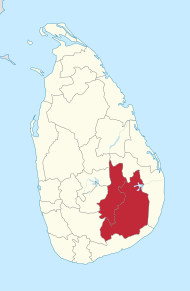Uva (Sri Lanka)
Coordinates: 6 ° 59 ' N , 81 ° 4' E
| Province of Uva ඌව පළාත (Ūva Paḷāta) ஊவா மாகாணம் (Ūvā Mākāṇam) |
|
|---|---|
| flag | |
| Capital : | Badulla |
| Area : | 8500 km² |
| Residents : | 1,259,218 (2012) |
| Population density : | 151 inhabitants per km² |
Uva ( singhales. ඌව පළාත) is the province of Sri Lanka with the second fewest inhabitants (1,187,335). It was founded in 1896.
It consists of the districts of Badulla and Moneragala . The capital is Badulla .
The main attractions for tourists are the Dunhinda, Diyaluma and Rawana waterfalls, the Yala National Park , which is partly located in the southern and eastern provinces , and the Gal Oya National Park . The latter also extends into the Eastern Province. The Gal-Oya hills and the central mountains are the highest elevations, the rivers Mahaweli (Sinhala: "large-sandy") and Menik (Sinhala: "precious stone") and the huge reservoirs Senanayake Samudraya and Maduru Oya are the most important waterways.
The Namunukula, which protrudes the highest from the mountains around Badulla, is symbolic of the province. On a clear day you have a spectacular view of the Welimada Basin, the Katharagama and the Hambantota Beach.
Mount Kirigalpottha is the highest mountain in the Haputale mountain range. From it you have a good view of the southern and Sabaragamuwa province.
history
In 1818 there was an uprising against the British colonial administration, which administered the formerly independent Udarata (Sinhala: "highlands"), whose province was Uva. The uprising was led by Keppetipola Dissawe , who is still revered by the Sinhalese today. He was originally sent by the British to end the uprising. The rebels captured Matale and Kandy until Keppetipola fell ill and was captured by the British and eventually beheaded. Since his head was wider than normal, he was sent to England for testing. After independence, it was returned to Sri Lanka, where it is now exhibited in the Kandy Museum.


